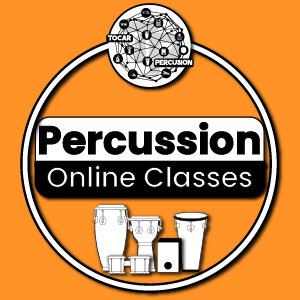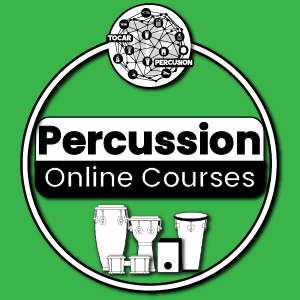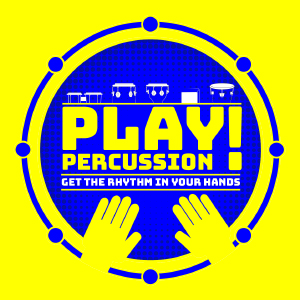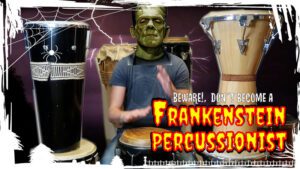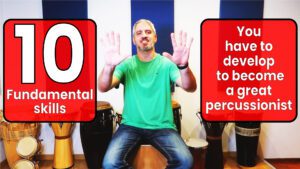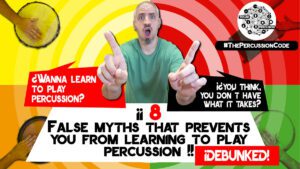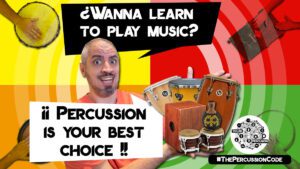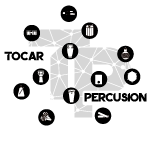Start your learning path in percussion today!
Which is the best instrument to start playing percussion?
Author: Facundo Alvarez, Percussion teacher and Facilitator
Do you want to learn to play percussion, but you don’t know which is the best instrument to do that.
This is your lucky day, because in this post I´m going to compare the instruments most chosen by people to learn to play percussion, taking into account different criteria that I believe are fundamental such as:
- the hand technique required to play them
- how difficult it is to learn to play them
- their performance in different musical contexts.
Keep reading, because in this post I´m going to answer all your doubts so you can start your learning path in percussion.
For the purpose of the video I selected percussions instruments that meet the following requirements:
- First, all of them are going to allow you to fully learn all the elements involved in the learning to play percussion.
- Second, each one of them has a main role in the music of a specific region of the world, so that makes them the best means to learn to play those music and rhythms.
- Third, to be able to compare them I selected only percussion instruments that are drums and that are played only with the hands, what I mean without any kind of sticks.
- Last, they´re the most chosen instruments by people who want to learn to play percussion.
So the idea is to compare these 5 instruments in 6 categories that I think are the most important when learning to play and music with percussion instruments.
In each of these categories I´m going to rank the instruments giving each one a score from 1 to 5 in which 1 is the lowest soccer and 5 is the best.
At the end the instruments are going to be ranked from highest to lowest scores according to the sum of the scores obtained in all categories.
Let’s move on then to the first category.
Category 1: Hand technique and sounds you need to play each drum
In this category the main criteria is the amount of sounds you need to play the drum and how difficult it’s to play, using all those sounds, the most characteristic rhythm of each drum.
CONGA
The first drum I´m going to analyze is the Conga that is a drum original from Cuba.
To play the conga you need 5 sounds: First, you have the tones that are played with full hand in the center on the drum. Second, you have the opens that you play with your palm and fingers in the border of the drums. Third, you have the slap that is played with the tip of your fingers in the middle of the drum. And last, you have the double strokes or as players call them “Palm — Finger” that is mostly played with your left hand.
One thing I need to comment is that from this 5 sounds the slaps is the hardest one, because beginner some time to make sound correctly.
As said before, congas is an afrocuban instrument and the most characteristic rhythm you can play in it is the Son Cubano. To play that rhythm you have to use the 5 sounds I mentioned before.
If you want to know about how to learn to play the congas from scratch, I recommend you visit this page.
CAJÓN
The second instrument I´m going to analyze is the Cajón a drum that comes from Perú.
To play the Cajón you need 3 sounds: first, you have the Tone or Bass sound that you play onthe center on the Cajón using your whole hand. Second, you have the open sound that you play with your fingers on the top the drum using your fingers, all of them. And last, you have a hit that is more a hand motion hit that a sound. Because of that we´re going to call them “Ghost Notes” and when we play them we going to try to make them sound as soft as possible.
One important fact about cajón is that unlike the majority of the drums included in the ranking, the sounds on the cajón mostly depends of the place in where you play the sound while in the rest of the drums is a matter both of the place of the drum and the position of your hand.
Cajón is original from Peru and the most traditional rhythm that you can play in it is the Afroperuvian Festejo. To play it you need to use the 3 sounds that I mentioned before.
BONGÓ
The third drum I´m going to analyze is the Bongo which also is original for Cuba as Conga.
First of all, unlike the rest of the instruments included in the ranking Bongó is played with fingers while the rest is played with the whole. This gives the bongó a little advantage over the others, because it makes the bongo easier to play.
To play the Bongó you need three sounds: first you have an open sound that you going to use both in the little and the big drum. So using the same hand technique the sound is going to be sharp when you play it in the little drum and low when you play it in the big drum. Last, you have a double stroke similar to the one it used in congas, but in this case it´s play it with the thumb and index of your left hand.
Bongó, like conga comes from Cuba, and the most known rhythm you can play in it is called “Martillo”. To play this rhythm on the Bongó you going to use the 3 sounds I mentioned before.
If you want to know about how to learn to play the bongo from scratch, I recommend you visit this page.
DJEMBÉ
The fourth drum I´m going to analyse is the Djembé that is drum that comes from Africa. You can find several tribes in the african continent that use the Djembe as main drum to make music.
To play the djembé you need 3 sounds: First, you have the tones that are played with full hand in the center on the drum. Second, you have the opens that you play with your palm and fingers in the border of the drums. And last, you have the slap that is played with the tip of your fingers in the middle of the drum.
The sounds and technique that you need to play this drum are pretty similar to the one you use to play the conga.
One of the most characteristic rhythm you can play on the Djembé is Kukú that is a rhythm original from Guinee. To play it you need to use the 3 sounds mentioned before.
TIMBAL BRASILERO
Last but not least we have the Timbal Brasilero, which as its name says comes from Brazil.
To play the timbal brasilero you need 4 sounds: First, you have the tones that are played with full hand in the center on the drum. Second, you have the opens that you play with your palm and fingers in the border of the drums. Third, you have the slap that is played with the tip of your fingers in the middle of the drum. And last, you have the ghost notes, pretty similar as the one you play in the cajón, which are played in the border of the drum.
Timbal brasilero has important role both in Samba and Samba Reggae percussion ensemble. One of the most characteristc rhythm that you can play in it is Afoxé. To play it you need to use the 4 sounds I described before.
Final Ranking Category 1
So, following the result of the analisis and comparasion the drums are ranked as follows, first is the Cajón that is the one that requires the easiest hand technique to play its most characteristic rhythm.
Then comes the bongó, and little behind also the djembé and the timbal.
And in last place is the Conga, that is the drum which has the more complex hand technique to play it.
Learn to play percussion online
¡Choose the way to learn to Play Percussion
that best suits your times and needs!
Learn to Play Percussion: Bongó, Conga, Cajón, Djembé, Timbal Brasilero
Percussion Online Classes
In the Online Percussion Classes, I offer individual and face to face classes for you to start learn to play percussion from scratch and learn to play and make music with the percussion instrument you like – Bongó, Cajón, Conga, Djembé or Timbal Brasilero.
Percussion Online Courses
In the Percussion Online Courses I offer you different virtual and self-paced courses options for you to start playing percussion from scratch and develop yourself as percussionist. Courses include several percussion instrument such as: Bongo, Cajón, Conga, Djembé or Timbal Brasilero.
Percussion Online Group Classes
In the Percussion Online Group Classes I offer grupal and face to face classes for you to start learn to play percussion from scratch and learn to play and make music with the percussion instrument you like – Bongó, Cajón, Conga, Djembé or Timbal Brasilero.
Activities suitable to all ages and levels
You don´t need to have previous knowledges of music or percussion to get started.
Category 2: Difficulty level to learn to play each drum
This category is complementary to the previous, because here we´re going to compare the 5 drums to see which one is harder to learn to make music.
So, leaving the hand technique aspects aside, we can say that the learning process with the different instruments are pretty similar. What I mean, the difficulties that you may face when learning to play music with them is going to be determined mainly by the complexity of the music you want to learn to play and not from the drum.
Final Ranking Category 2
So in this category we have a tie between all the drums.
Category 3: Musical versatility of each drum
In this category we´re going to compare the 5 drums depending on their versatility when using them to make music. What I mean is the sounds and musical resources that each one gives us to make music and play different kinds of music styles.
For starts, we can say that Djembe and Timbal are two drums that are strongly identified with their birthplace, both in sound and rhythm. In both cases, the moment we play any of them and listen to their sound, Africa and Brazil come to mind.
What I mean is, when someone hires me for a gig or a recording and he wants the percussion to sound African he asks me to play the Djembe, or If he wants the percussion to sound Brazilian he´ll ask me to play the timbal.
Following this, it is more difficult to use those instruments in recordings and gigs of music of other styles than the ones I mentioned before.
On the opposite side we can place the cajón, la conga and the bongo that are the drums most commonly seen in all kinds of musical groups and bands. In my experience, both on live gigs and in the studio they´re the most required instruments.
That’s because of its versatility that allows you to play several music styles like: pop, rock, latin music, funk, reggae, among others.
Cajón, also has an additional advantage since it´s the only of the 5 drums that can replicate, almost perfectly, the sound and functionality of the drumste. That makes de cajón very useful for acoustics groups.
Final Ranking Category 3
In this category the 5 drums are ranked like is:
In first place is the cajon, that is the more versatile drum of all.
In second place are the Conga and the Bongó.
And last you can find the Djembe and the Timbal.
Category 4: Drum performance in acoustic musical contexts
In this category I´m going to compare the 5 drums by their performance in an acoustic musical context, what I mean in music groups that don’t have drumset so any of the drums included in this video are in charge of playing the rhythm base of the songs.
Final Ranking Category 4
Taking under consideration the resources each drum provides we can say that the Cajón is the one that stands out the most in this category. That is because of its versatility and also for the fact that it can mimic and replicate almost exactly the sound and functionality of the drumset.
First comes the Cajón that is the instrument that provides better resources in this category. Second comes the conga, that although it does not provide the same resources at the Cajón it can work great in acoustic contexts. The same can be said about the Bongó.
In last place, we can find the Djembé and the Timbal which have a limited musical range because of the specific sound and its relation with their birthplace music.
Category 5: Musical performance when they play along a Drumset
If we refer to what we can see in videos of recitals, video clips or recordings of various musical groups, conga and bongo are the most used instruments by bands that play several music styles such as: pop, rock, funk, reggae, dance music, electro music, among others.
Final Ranking Category 5
After them are the Djembe and the timbal, which stand out in world music bands.
Category 6: Level of fun reached by learning to play each drum
In this category we have a clear tie between the 5 drums.
Learning to play and make music with any of them is absolutely fun. Also, each one of them propose different and interesting challenges to learn to play percussion and develop as a percussionist.
Final Comments
Before I move into the final results I´m going to comment on two criterias that come out when my students ask me about what instrument they can buy to learn to play percussion.
I didn’t include them in the ranking because they are not related to playing or making music with them, but I think that it is important to talk about them.
First, is the price. What I mean is, compare them by their price and see which one is cheaper and which is the more expensive. Although we can rank them by price, I don’t recommend doing that. In my opinion, when choosing your drum it is better to think about music you want to play and what you want to learn with it.
Second, is comfort. What I mean is the comfort of transporting it or the comfort related to the space that the instrument occupies in your home. As in the previous case, don´t choose your instrument for any of these reasons. Again, focus on your goals and the music you want to play to choose it.
Final Ranking
We arrived to the moment we´re waiting for, the final ranking of the best instrument to learn to play percussion is the following:
In the first place of the ranking is the Cajón, followed by the Conga and the Bongó.
In last place are de Djembé and the Timbal
So they you have this is the ranking of the best instrument to start learning to play percussion.
I hope you found this post useful and entretaining, and also that it helped you to decide with instrument to choose to start your learning path in percussion.
Thanks for reading the post!.
Read more post
percussion facilitator
Facundo Alvarez
Percussion Facilitator
For 20 years I´ve dedicated myself to develope educational and recreational materials and experiences, with the goal of facilitate access to percussion learning to people of all ages
In all the projects I work motivated by the premise that "Percussion is for everybody" and that "Everyone can learn to play percussion".
My main goal is to help, as many people as I can, to live the unique experience of making music with percussion instruments.
